🎯 Tennis Serve Introduction
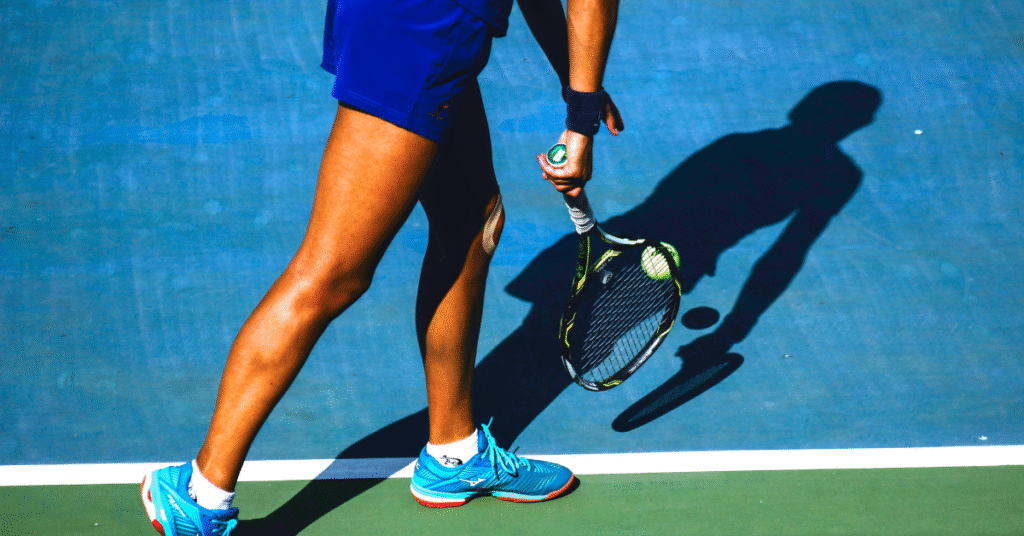
The tennis serve is often called the most important shot in tennis.
It starts every point, sets the tone for rallies, and can instantly put your opponent on the defensive.
A strong tennis serve isn’t just about pure power — it’s a blend of precise technique, smart strategy, and mental toughness.
Whether you’re just learning how to serve in tennis, aiming to develop a fast tennis serve, or refining advanced tactics like the kick serve, this complete guide is designed to transform your serve step by step.
Unlike many articles that only skim the surface, this guide dives deep into every detail:
- From your toss to your mental approach
- From tennis serve grip adjustments to pro-level case studies
You’ll also find dedicated sections on different types of tennis serves, tactical use of the serve and volley tennisstrategy, and specialized tennis serve drills to build consistency and power.
By the end, you’ll know how to hit a flat serve, master a heavy kick serve, and even develop a reliable second serve.
✅ You’ll be ready to step up to the line with complete confidence — no matter your level.
🏆 The Fundamentals of the Tennis Serve
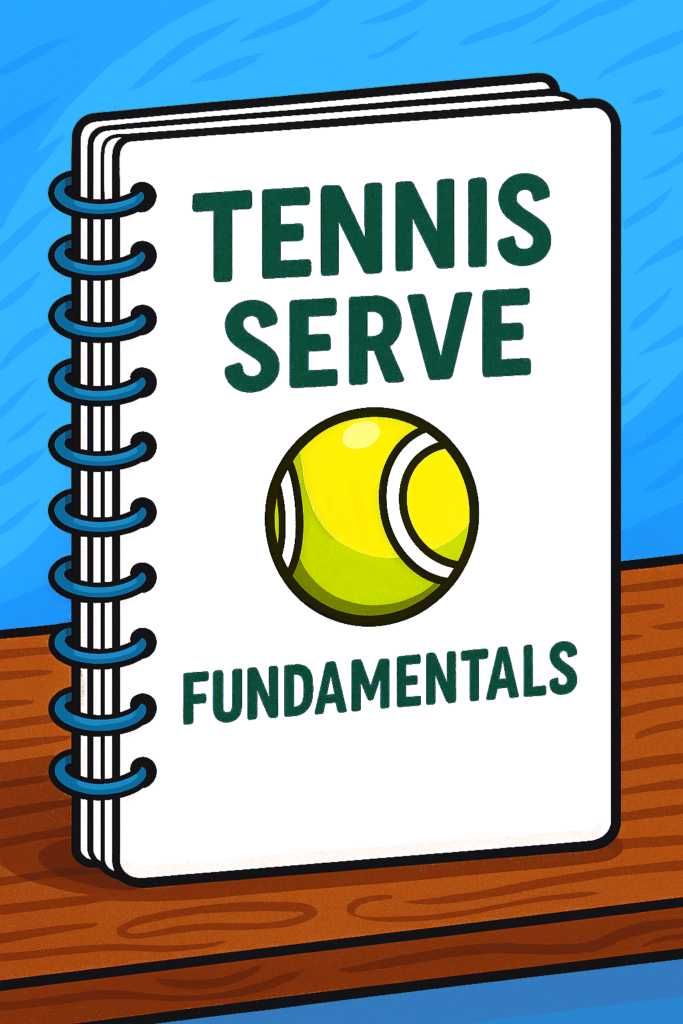
Before you can unleash a truly powerful or fast tennis serve, you need a strong foundation.
These core fundamentals build the base for everything else, from tennis serve power to reliable placement.
🎾 The Toss: Placement and Timing
The tennis toss is the hidden secret behind every great serve.
A consistent toss ensures proper timing, balance, and allows you to disguise different types of tennis serves (like flat, slice, or kick).
✅ Keep your arm straight and release the ball smoothly from your fingertips.
✅ Toss slightly in front and to your hitting side to promote forward momentum.
✅ Practice tossing without hitting to build repeatability and reduce double faults.
Many players underestimate the toss, but it directly affects your serve’s speed, spin, and control.
Without a great toss, even the strongest player can struggle with tennis serve consistency.
⚖️ Stance and Balance
A stable stance creates a powerful, reliable base for your tennis serve.
✅ Stand sideways to the baseline, feet shoulder-width apart.
✅ Keep weight balanced before starting your motion.
✅ As you toss, shift your weight forward and stay relaxed to maximize tennis serve power.
🔄 Weight Transfer and Kinetic Chain
Generating power in your tennis serve is all about connecting your entire body — known as the kinetic chain.
✅ Bend your knees and coil your torso during preparation.
✅ Drive upward explosively using your legs and hips.
✅ Let that energy flow seamlessly through your shoulder, arm, and racket head.
This full-body motion is what produces effortless tennis serve speed and consistent depth.
💬 “Master your toss and kinetic chain first — they’re the true keys to a powerful and reliable tennis serve.”
🧩 Foundation for Every Style
Whether you’re developing a fast tennis serve, practicing a precise flat serve, or learning a heavy kick serve, these fundamentals stay the same.
Once your foundation is strong, you can explore advanced variations and tactics with confidence.
💪 How to Generate Power in Your Tennis Serve
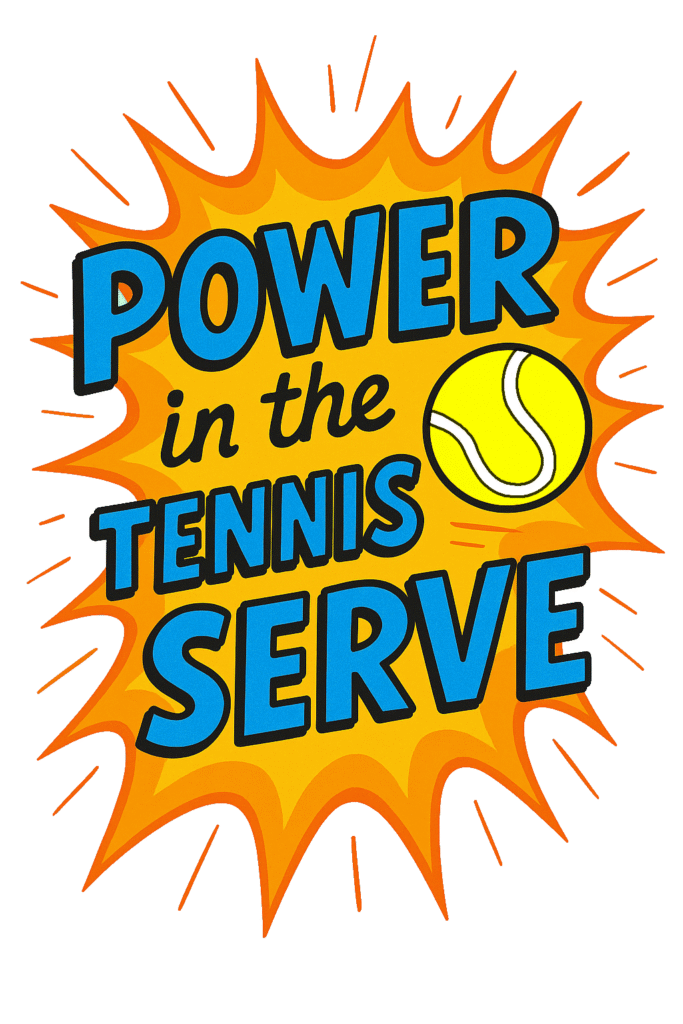
A truly powerful tennis serve isn’t about swinging harder — it’s about using your entire body efficiently.
Generating power requires mastering the kinetic chain, perfecting arm mechanics, and understanding how to create effortless racket head speed.
Whether you’re aiming for a fast tennis serve or a heavy kick serve, these power fundamentals are crucial.
🔗 Related: Modern Tennis Forehand: Power and Precision — learn how forehand power mechanics mirror your serve.
🏋️♂️ Use Your Legs and Core (Kinetic Chain)
The secret behind a strong tennis serve is not just in your arm — it starts from the ground up.
✅ Bend your knees deeply during the trophy position.
✅ Explode upward, pushing off the ground to transfer energy through your hips and torso.
✅ Rotate your shoulders and core smoothly into the swing.
Think of your legs and core as the engine; your arm and racket are simply finishing the job.
💪 Arm and Wrist Mechanics
Once the energy travels up the kinetic chain, your arm and wrist become key to adding whip and acceleration.
✅ Keep your elbow relaxed and lead with your racket edge (“edge first”) in the drop phase.
✅ As you approach contact, snap your forearm and wrist through the ball for extra speed and spin.
✅ Avoid muscling the ball with a stiff arm — this often causes shoulder strain and kills racket head speed.
⚡ Maximize Racket Head Speed
A fast tennis serve relies heavily on racket head speed at the moment of contact.
✅ Relax during the swing to prevent tension from slowing you down.
✅ Use a fluid motion rather than forcing acceleration too early.
✅ Focus on finishing high and loose to promote a full follow-through.
💬 “The best servers don’t swing harder — they swing smoother and faster through the ball.”
⚠️ Common Mistakes That Kill Power
Many players unknowingly sabotage their own tennis serve power. Let’s fix these common errors:
❌ Arming the serve: Using only your arm without involving the lower body and core.
✅ Fix: Engage your legs and hips; think of pushing up, not just forward.
❌ Late racket drop: Delayed or incomplete racket drop reduces whip and acceleration.
✅ Fix: Start dropping the racket as you reach the top of your toss, not after.
❌ Over-gripping: Gripping the racket too tightly limits wrist snap and fluidity.
✅ Fix: Maintain a relaxed grip — think “holding a bird” rather than “choking a hammer.”
🔗 Related: Why Is My Backhand So Weak? — learn how relaxed technique and body coordination apply to every shot.
🎯 Your Foundation for a Fast Serve
Whether your goal is a first serve tennis bomb or a safe, powerful second serve, the same power principles apply.
Powerful serves come from smooth energy transfer, loose wrist acceleration, and a confident follow-through.
Once you master these mechanics, adding spin variations and disguise becomes far easier.
✋ Choosing Your Tennis Serve Grip (Updated)
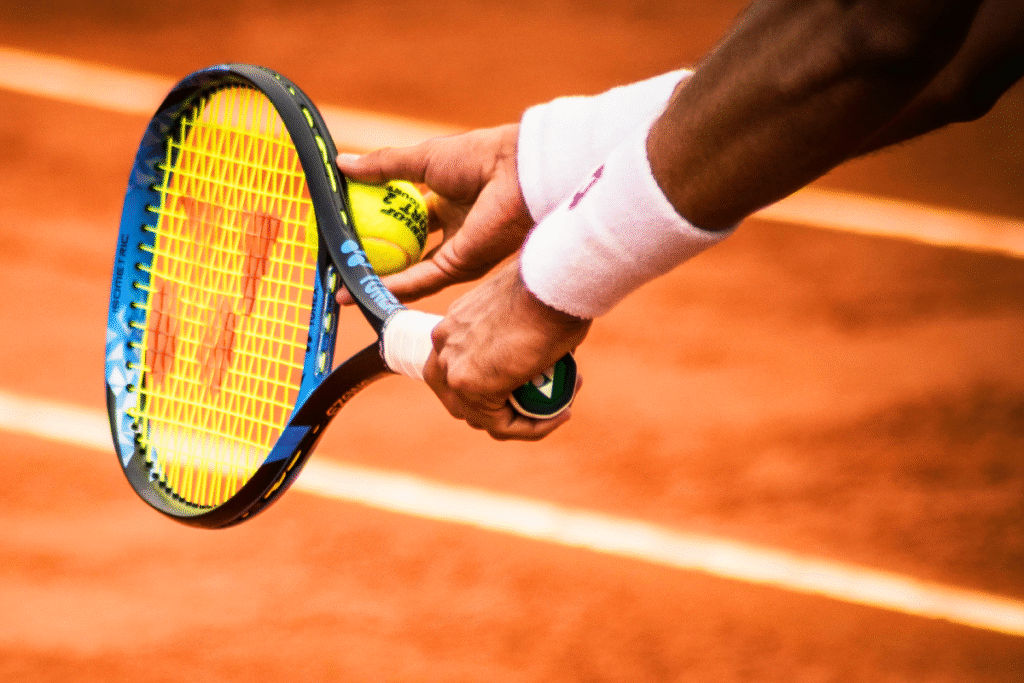
Your tennis serve grip is the foundation for every type of serve.
Without the correct grip, generating spin, power, and consistency becomes almost impossible.
Many recreational players overlook this critical detail and wonder why their serves lack speed or curve.
Let’s break down how to choose and adjust your grip properly.
🎾 The Continental Grip (The Gold Standard)
The Continental grip is the universal choice for nearly all tennis serves.
✅ Ideal for flat serves, slice serves, and kick serves.
✅ Allows for natural wrist pronation and smooth racket drop.
✅ Helps disguise different types of tennis serves without changing hand position.
To find it, hold the racket like a hammer (index knuckle on bevel 2). This grip allows you to snap through the ball effectively and create topspin or slice as needed.
💬 “Every top-level player, from Federer to Djokovic, relies on the Continental grip for serving. It’s the only truly versatile and efficient option.”
🤲 Grip Pressure: The Secret Ingredient
Even with the correct tennis serve grip, your pressure matters.
✅ Hold the racket firm enough to control it but loose enough to allow wrist snap.
✅ Over-gripping leads to tension, reduces racket head speed, and increases injury risk.
Imagine “holding a bird” — secure, but not crushing.
⚠️ Grips You Should Avoid for Serving
❌ Eastern Forehand Grip
Some beginners mistakenly use an Eastern forehand grip (index knuckle on bevel 3) when learning to serve because it feels strong or familiar from groundstrokes.
However, this grip severely limits wrist pronation, making it difficult to generate topspin or effective slice. It also increases the risk of arm injuries.
❌ Semi-Western Forehand Grip
Even more extreme is the Semi-Western forehand grip, which some players use by accident when transitioning from groundstrokes.
This grip is designed for heavy topspin on forehands, not for serves. Using it on serve:
- Reduces your ability to hit flat or slice serves.
- Increases the chance of mishits.
- Limits variety and disguise.
💬 “If you want a powerful, versatile serve, the Continental grip is non-negotiable.”
🎯 Practicing Your Grip
✅ Shadow serve swings without a ball to engrain the feel.
✅ Use video feedback to ensure no accidental grip shifts.
✅ Check your grip during the toss phase — many players unknowingly adjust mid-motion.
🔗 Related: Tennis Backhand Grip and Technique Guide — explore how grip impacts control on other shots too.
Choosing the right tennis serve grip unlocks all advanced techniques — from developing a fast tennis serve to creating a reliable second serve under pressure.
⚡ Types of Tennis Serves & When to Use Them
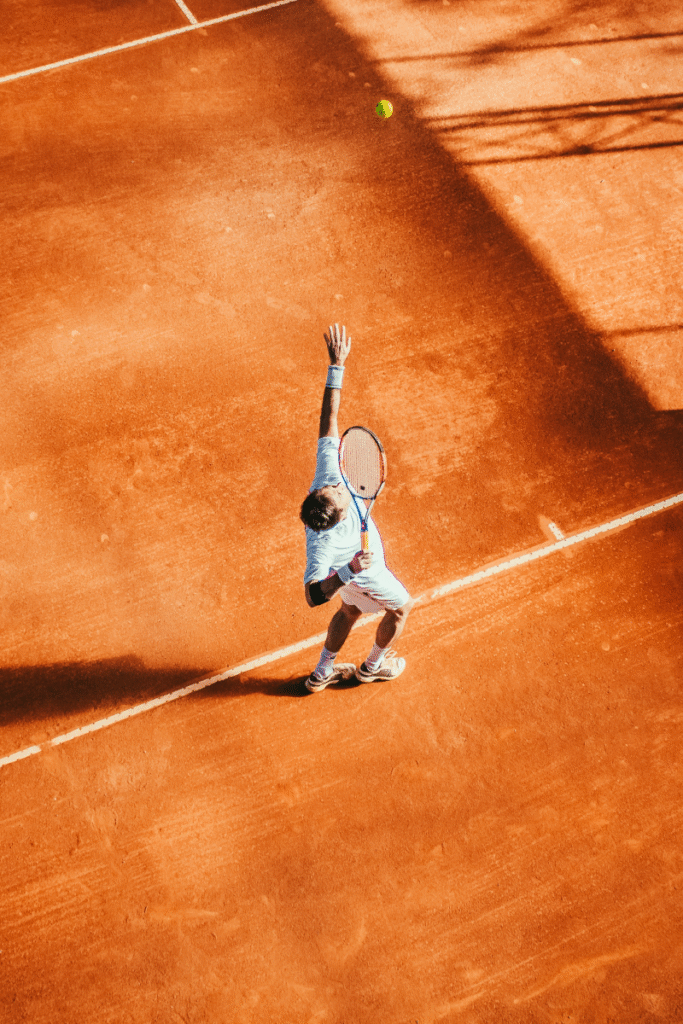
A strong tennis serve isn’t just about hitting hard — it’s about using different types of serves to control your opponent.
Varying your serve keeps opponents guessing and lets you take charge of every point.
Let’s break down each serve type in detail.
💥 Flat Serve
The flat serve is all about pure speed and direct power.
✅ Minimal spin means the ball travels fast and straight.
✅ Lower net clearance allows you to aim aggressively at corners and lines.
✅ Perfect for hitting aces or forcing weak, defensive returns.
When to use it:
- As a first serve tennis weapon when you want to start points on your terms.
- On big points to go for winners and apply mental pressure.
⚠️ It’s riskier due to smaller margins for error, so you need confidence and solid technique.
🌪️ Slice Serve
The slice serve uses sidespin to curve the ball away from your opponent.
✅ After landing, the ball stays low and skids, pulling opponents off the court.
✅ Great for opening up space and forcing returners out wide.
✅ Easier to control than a flat serve, with a higher success rate.
When to use it:
- On the ad side to drag right-handed players off the court.
- To set up an easy next shot into the open court.
- On faster surfaces where the low bounce is more effective.
🌀 Kick Serve
The kick serve (also called topspin serve) generates a high bounce that jumps above your opponent’s strike zone.
✅ The heavy topspin makes it safe and consistent, with extra net clearance.
✅ Forces opponents to hit higher contact points, making aggressive returns harder.
✅ Extremely effective on clay and slower hard courts where it bounces even higher.
When to use it:
- As a second serve tennis option to reduce double faults and build confidence.
- Against aggressive returners to push them back behind the baseline.
🎯 Underhand Serve
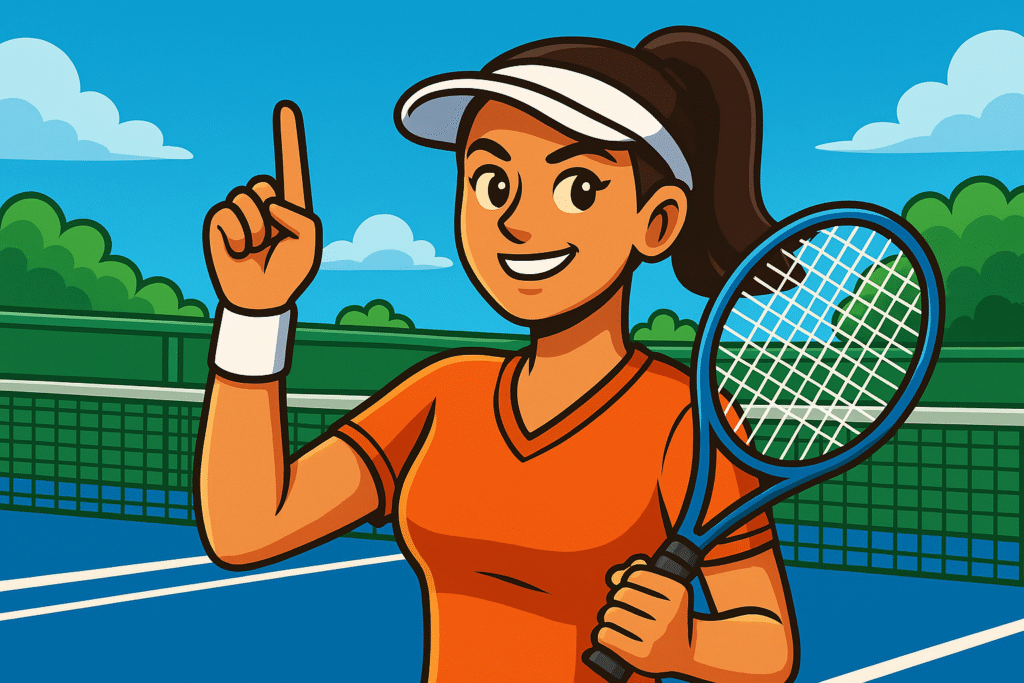
The underhand serve is a surprising, tactical option rather than a main weapon.
✅ Breaks the opponent’s rhythm completely.
✅ Takes advantage of players who stand far behind the baseline.
✅ Can win free points by catching opponents off guard.
❌ However, it is often viewed as disrespectful, especially in professional or competitive settings.
When to use it:
- When opponents consistently position very deep to return your kick or flat serves.
- As a sudden change-up to create doubt and force mental errors.
⚠️ Important: The underhand serve should be used extremely sparingly.
You might go many matches without ever using it, and ideally no more than once per match.
Overusing it makes it predictable and can backfire badly.
Even at the professional level, the underhand serve is used only on rare occasions.
When it is used, it’s often seen as a cheeky or even disrespectful move unless executed very tactically.
Many players and fans consider it more of a surprise trick than a reliable strategy.
💬 “A smart serve variety keeps your opponent guessing — power alone rarely wins the mental battle.”
🎾 Why Mix It Up?
Using different types of tennis serves is about more than technique — it’s about strategy and psychology.
A player who mixes serves well can:
- Open up easy attack opportunities.
- Disrupt timing and rhythm.
- Keep opponents physically and mentally uncomfortable.
🔗 Related: Modern Tennis Forehand — learn how to convert serve setups into aggressive forehand finishes.
By mastering all types of tennis serves, you’ll build a service game that’s unpredictable, versatile, and ready for any opponent.
🔥 Developing a Fast Tennis Serve
Many players dream of a fast tennis serve — that explosive shot that earns free points and intimidates opponents.
But achieving true serve speed isn’t just about swinging harder.
A truly fast tennis serve comes from mastering mechanics, timing, mental approach, and consistency. Let’s break it all down.
💪 Technique Over Muscle
Most players mistakenly try to muscle the ball with their arm alone.
✅ Instead, focus on fluid energy transfer from legs to hips to shoulders.
✅ Maintain a relaxed grip and loose arm to maximize racket head speed.
✅ Use the kinetic chain (legs → hips → core → shoulder → arm → wrist → racket) as your power engine.
💨 Timing and Rhythm
The key to a fast tennis serve is smooth, rhythmic acceleration.
✅ Start slow during your preparation and toss phase.
✅ Gradually increase speed as you move into the trophy position and racket drop.
✅ Explode upward through contact for maximum acceleration.
Think of it like cracking a whip — it’s about timing, not brute strength.
⚖️ Balance and Body Alignment
A balanced body position allows you to deliver power without sacrificing control.
✅ Keep your head steady throughout the toss and coil.
✅ Avoid leaning too far forward or falling sideways.
✅ Finish with a balanced, strong landing inside the court.
A well-balanced finish sets you up perfectly for aggressive first shots after your serve.
🧠 Mindset and Confidence
A fast tennis serve also relies heavily on your mindset.
✅ Commit fully to the motion; hesitation reduces speed.
✅ Visualize a fast, clean contact point before serving.
✅ Use breathing or mini rituals to stay relaxed under pressure.
💬 “The fastest serves come when you trust your body and stay out of your own way.”
🎯 Practice Drills for Serve Speed
✅ Shadow serve acceleration drill: Practice going through the full serve motion without the ball, focusing on explosive upward energy and relaxed finish.
✅ Target zones drill: Aim for deeper corners and center T to build power and directional control at the same time.
✅ Serve plus first-shot drill: Practice combining a fast serve with an aggressive first groundstroke to simulate match pressure.
🔗 Related: Why Is My Backhand So Weak? — learn how mental commitment affects all strokes, not just serves.
⚡ Beyond Raw Speed
A fast tennis serve isn’t useful if it lacks placement and consistency.
✅ Combine speed with smart targeting to keep opponents guessing.
✅ Develop second serve confidence to avoid playing timidly on big points.
✅ Remember: a well-placed 100 mph serve often wins more points than a wild 120 mph blast.
By focusing on technique, rhythm, balance, and mental trust, you’ll gradually build a fast tennis serve that’s both dangerous and dependable.
🧠 The Mental Game of Serving
A great tennis serve is as much a mental weapon as it is a technical one. Even with perfect mechanics, your serve can break down without strong focus, trust, and mental preparation.
⚠️ Overcoming Double Faults
Double faults are more mental than mechanical.
✅ Focus on your pre-serve routine rather than worrying about the result.
✅ Commit to your chosen target fully — hesitation is the real enemy.
✅ Use a reliable second serve you trust, like a solid kick serve, to avoid fear-driven errors.
By reducing overthinking and trusting your motion, you’ll dramatically cut down double faults and build confidence.
💨 Building a Pre-Serve Routine
A solid routine keeps your mind steady and blocks distractions.
✅ Develop simple rituals: bouncing the ball, breathing deeply, or visualizing your serve path.
✅ Stick to the same routine regardless of score or situation — this creates a mental “safe zone.”
✅ Your routine helps you transition from thinking to automatic execution.
🔥 Power Through Mental Commitment
True tennis serve power isn’t just physical — it’s unlocked through mental commitment.
When you hesitate or try to “guide” the ball, your body tightens, and you lose racket head speed.
✅ Trust your swing fully and focus on accelerating through contact.
✅ Visualize the energy moving from your legs to your racket in one fluid motion.
✅ Think “up and out” rather than “hit hard” — this prevents muscling and promotes effortless power.
💬 “True serve power starts in your mind — commitment turns stored energy into explosive speed.”
🌀 Trusting Your Energy Flow
Serving powerfully means learning to trust the energy storage and release in your body.
✅ During the coil and knee bend, you store elastic energy (think of a coiled spring).
✅ The moment you uncoil and push up, that stored energy is released in one continuous, fluid chain.
✅ Focusing on this flow stops you from overcontrolling or chopping at the ball.
When your mind lets the body do its job, your serve transforms from forced to fluid.
💪 Serving Under Pressure
Big points test your mental strength the most.
✅ Stick to your routine rather than trying to add extra power or make last-second adjustments.
✅ Choose your most confident serve — not always the fastest one.
✅ Narrow your focus to a single clear target and commit completely.
🔗 Related: Why Is My Backhand Better Than Your Forehand? — discover how confidence upgrades every shot, not just your serve.
🌟 Visualization and Positive Self-Talk
Your mind needs clear, positive instructions to execute under stress.
✅ Visualize your ideal ball trajectory before starting your motion.
✅ Use simple, positive cues like “smooth and up,” “trust and swing,” or “fast and loose.”
✅ Avoid negative self-talk like “don’t miss” — it invites tension and hesitation.
💬 Key Takeaway
By mastering the mental game, your tennis serve evolves from just a shot into a true psychological weapon.
You’ll learn to trust your preparation, swing confidently, and maintain power even under extreme pressure.
🏆 Pro Case Studies
Learning from professional players is one of the best ways to master your tennis serve.
Rather than just copying, you can adopt elements that fit your style and body mechanics.
Let’s break down some of the most effective modern serves and what you can learn from them.
🎯 Roger Federer: Precision and Disguise
Federer’s tennis serve isn’t the fastest, but it’s one of the most effective ever.
✅ Smooth motion and consistent toss make it nearly impossible to read.
✅ Masterful placement, constantly mixing directions and spins.
✅ His serve sets up his attacking forehand and finishes points quickly.
Lesson: Placement and disguise can be more dangerous than pure speed.
💣 Matteo Berrettini: The Power Blueprint
Berrettini’s serve is among the biggest on tour.
✅ Simple, repeatable motion that minimizes errors and maximizes confidence.
✅ Deep knee bend and strong upper body coil generate explosive power.
✅ His first serve is the foundation of his aggressive game, setting up immediate offense.
Lesson: A reliable, powerful first serve can anchor your entire strategy.
🧊 Daniil Medvedev: The Deceptive Tower
Medvedev’s tennis serve is unique and extremely effective.
✅ Uses a long, relaxed arm and deep knee bend to generate big power with less effort.
✅ Highly effective at creating unpredictable angles, especially wide on both sides.
✅ Often starts points with deep, unreturnable serves, controlling rallies immediately.
Lesson: You can be unorthodox and still build a world-class, consistent serve by maximizing what works for your body.
⚡ Ben Shelton: Momentum and Explosive Energy
Shelton’s serve is already feared across the ATP Tour.
✅ Left-handed delivery creates sharp angles and tricky spin.
✅ Uses a whip-like, elastic motion that maximizes energy transfer.
✅ His standout feature: bends his knees immediately and uses momentum so efficiently that no energy is lost — every ounce of stored power flows upward into the serve.
✅ Consistently delivers 135+ mph serves with confidence.
Lesson: True power isn’t just about raw strength — it’s about seamless energy flow and fearless commitment.
💡 Integrate What Fits Your Game
You don’t have to copy any one pro exactly. Instead:
- Want placement and disguise? Study Federer.
- Need a big first serve? Learn from Berrettini.
- Prefer an unorthodox yet effective approach? Watch Medvedev.
- Want explosive athleticism? Take inspiration from Shelton.
🔗 Related: Modern Tennis Forehand — see how top players use serve plus first shot combos to take early control.
By studying these modern pro servers, you’ll build a tennis serve that matches your style, enhances your strengths, and wins you more free points at every level.
🎯 Tennis Serve Drills to Build Consistency
A powerful tennis serve is useless without consistency. You need to trust it under pressure and reproduce it point after point.
Drills are the bridge between technical knowledge and reliable match-day performance. Let’s break down the best serve drills to sharpen your skills and confidence.
🎾 Shadow Serve Drill
✅ Practice your full serving motion without a ball.
✅ Focus on smooth toss, deep knee bend, and relaxed follow-through.
✅ Build muscle memory and improve rhythm without the pressure of hitting.
🎯 Target Zones Drill
✅ Place cones or small targets in different service box areas.
✅ Aim for wide serves, T serves, and body serves.
✅ Repeat each target 10–20 times before moving on.
This improves accuracy and builds your ability to choose spots intentionally during matches.
🌀 Second Serve Confidence Drill
✅ Focus on hitting kick serves or heavy spin serves with high net clearance.
✅ Challenge yourself to hit 20 second serves in a row without a double fault.
✅ Helps remove fear and makes your second serve a true weapon.
🚀 Serve Plus First Shot Drill
✅ Serve, then immediately hit a forehand or backhand as your first groundstroke.
✅ Train to transition quickly from serve to aggressive play.
✅ Simulates real match points and builds anticipation skills.
🎾 High-Toss Consistency Drill
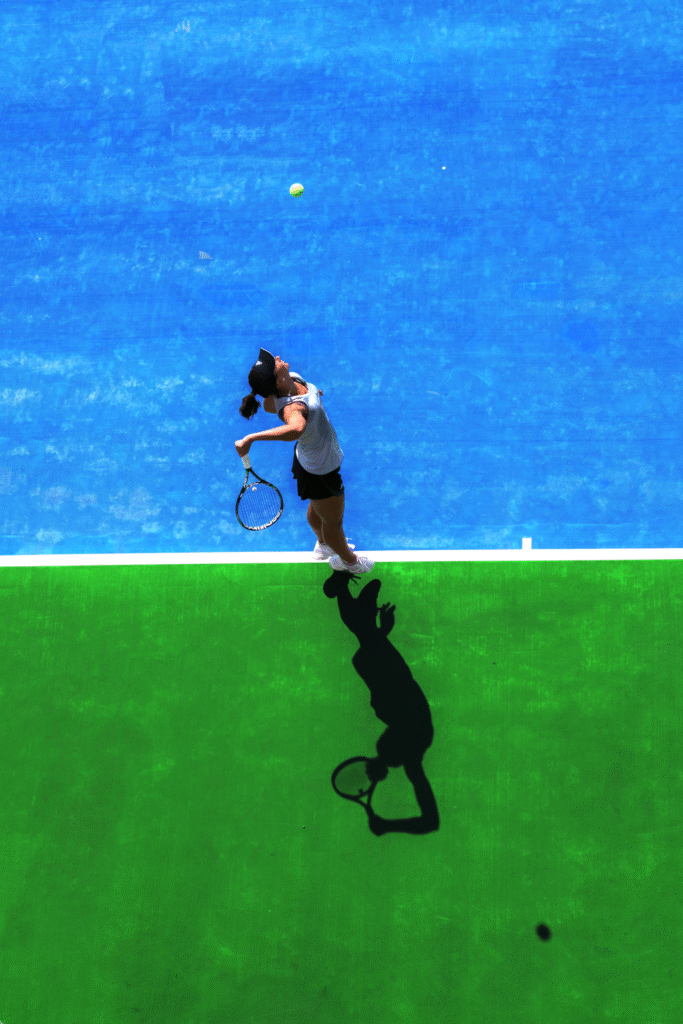
✅ Toss and catch the ball without hitting, ensuring it lands consistently in the same spot.
✅ Corrects erratic tosses, a common source of inconsistency.
⚡ On-the-Run Serve Drill
✅ Serve, then practice moving into court for a quick volley or forehand approach.
✅ Builds confidence in using your serve to take control of the net.
💬 “Repetition builds trust — the more you practice these drills, the more your serve will hold up when it matters most.”
🌀 Kick Serve Height and Placement Drill
✅ Place a towel just past the service line (closer to the baseline side of the service box).
✅ Practice hitting kick serves so the ball lands beyond the towel but still inside the box.
✅ Forces you to get more net clearance and shape on the ball, producing a higher bounce that pushes opponents back.
Bonus: Focus on brushing “up and out” to emphasize topspin rather than just forward force.
⚡ Flat Serve Precision and Pronation Drill
✅ Place a towel right on or just inside the service line where you’d normally aim your flat serve (T or wide).
✅ Focus on hitting flat serves that land directly in front of or over the towel.
✅ Helps train precise placement and encourages full pronation — the wrist “snap” at contact that flattens the ball and adds speed.
Tip: Think “palm to the side fence” after contact to reinforce proper pronation.
💬 “The smallest adjustments can create the biggest breakthroughs — precision drills turn raw power into match-winning weapons.”
🔗 Related: Why Is My Backhand So Weak? — learn drills to build trust in other strokes as well.
💡 Key Takeaway
Consistency isn’t about playing it safe — it’s about owning your technique so deeply that it holds up under pressure. These drills create a solid foundation that turns your tennis serve into a true match-winning weapon.
🚀 Advanced Tips for the Modern Game
Once you’ve built solid fundamentals, it’s time to add advanced layers to your tennis serve — the details that separate great servers from good ones.
These tips help you stay unpredictable, adapt to different surfaces, and keep opponents under constant pressure.
🎭 Mastering Disguise and Deception
Disguise is one of the most underrated weapons on serve.
✅ Use the same toss position for different serve types (flat, kick, slice).
✅ Keep your body posture and racket drop identical as long as possible.
✅ Avoid obvious pre-serve cues like exaggerated toss angles or body lean.
Pro tip: Watch Federer and Medvedev — their tosses look nearly identical no matter the spin or direction.
🎢 Mixing Spins and Speeds
If you only hit big flat serves, opponents start reading and timing you. Mixing spins and speeds:
✅ Makes returns uncomfortable and forces defensive replies.
✅ Helps you reset rhythm and take control of points.
✅ Reduces physical strain by varying effort and motion.
Alternate heavy kick serves with flat bombs and sudden slices out wide to keep returners guessing.
🌱 Adapting to Different Surfaces
Each court surface affects your tennis serve differently.
✅ Clay: High-bouncing kick serves are extremely effective. Use more spin and margin.
✅ Grass: Lower, skidding slices work well; serve-and-volley tactics thrive.
✅ Hard court: Balanced mix — both flat and kick serves can be used depending on opponent positioning.
Always scout surface behavior during warm-up to fine-tune placement and spin.
⚔️ Serve as a Setup Weapon
Don’t think of your serve as an isolated shot — it should set up your next move.
✅ Plan where you want to place your first groundstroke.
✅ Use wide serves to open up the court for an aggressive forehand.
✅ Mix in body serves to jam opponents and earn weak replies.
💬 “A smart serve doesn’t just win free points — it scripts the point in your favor from the start.”
🔗 Related: Modern Tennis Forehand — learn how to connect your serve with aggressive first shots to control rallies.
💡 Key Takeaway
These advanced layers make your tennis serve a true weapon, not just a rally starter.
By mastering disguise, mixing spins and speeds, adapting to surfaces, and planning point patterns, you’ll transform from a predictable server into a nightmare opponent.
💬 My Personal Serve Journey (Expanded)
As a dedicated serve-and-volley player, my tennis serve was the cornerstone of my entire strategy.
One thing that truly separates great servers from the rest is the ability to develop a big serve — and here’s the truth: you don’t need to be tall to achieve it.
I’m only 5’7″, and at just 16 years old, I had already developed a 111 mph first serve.
This isn’t to brag — it’s a sign that you can absolutely reach (or even surpass) this level, especially if you’re taller.
With the right technique and focus, height becomes an advantage, not a requirement.
💡 The two most important factors
✅ Technique and contact point:
- Mastering clean mechanics and striking the ball at the optimal point above your head is far more crucial than sheer muscle power.
- A well-timed contact point allows you to maximize energy transfer and control.
✅ Explosive strength and biomechanics:
- True power starts from the ground up.
- Your legs generate the initial drive, which flows through your hips, core, shoulders, arm, and finally the wrist.
- It’s not about swinging as hard as possible — it’s about fluid, explosive motion that builds effortless speed.
💬 “A powerful serve isn’t measured by your fastest single strike, but by the consistent average speed and reliability of both your first and second serves.”
⚡ The importance of shoulder-over-shoulder tilt
In my opinion, it’s not a bad thing to miss a first serve — you should be taking more risk if it’s your weapon.
However, you should never miss a first serve into the net.
Even shorter players can overcome net errors easily by mastering the shoulder-over-shoulder tilt, which is a vertical rotation that helps you clear the net and add power to your serve.
✅ This upward movement encourages you to drive vertically rather than rotate sideways, which can cause inconsistency and low serves.
On the second serve, you should also never miss in the net.
✅ Spin is the most crucial element, and from there, you can gradually add power once you trust the motion.
✅ Massive spin and safety are the number one priorities.
One of my favorite examples is Reilly Opelka — yes, he’s extremely tall, but even he prioritizes massive spin on his kick serve rather than just flat power.
💬 My challenge to you
Try these adjustments, trust the vertical shoulder tilt, and focus on spin — your entire serve game will transform exponentially.
💡 Key takeaway
A big serve isn’t reserved for the tallest or strongest — it’s built through dedication to technical mastery, smart biomechanics, and mental trust in your motion.
🎾 Which Serve Style Should You Use?
Choosing your ideal tennis serve style depends on your physical attributes, playing style, and mindset.
There is no universal “best” serve — the key is finding what feels natural and builds confidence under pressure.
💡 Beginner Players
✅ Focus on developing a consistent first serve with a simple motion.
✅ Use a continental grip and avoid experimenting with extreme spins early on.
✅ Prioritize placement and solid contact rather than pure speed.
⚡ Intermediate Players
✅ Begin exploring different spins (kick, slice) and start mixing locations.
✅ Work on adding more power through leg drive and shoulder-over-shoulder tilt.
✅ Build a dependable second serve that uses heavy spin to reduce double faults.
🔥 Advanced Players
✅ Optimize serve variety to keep opponents guessing: flat bombs, wide slices, and heavy kicks.
✅ Focus on using the serve as a point-starting weapon rather than an isolated shot.
✅ Study pro examples and integrate advanced disguise and tactical placement.
💬 Style depends on your strengths
- Love rushing the net? Prioritize a big, accurate first serve and strong wide placements to set up easy volleys.
- Prefer baseline rallies? Use spins and placement to push opponents out wide and control the next shot.
- Athletic and explosive? Work on a mix of flat and kick serves like Ben Shelton, using leg drive to generate maximum energy.
💬 “The best serve style is the one you trust the most when it matters — under pressure, in tight moments, and when the match is on the line.”
💡 Key takeaway
Don’t force yourself into a single mold. Test, refine, and evolve your tennis serve style as your game develops.
Confidence and consistency are always more important than raw power alone.
✅ Final Thoughts
Your tennis serve is much more than just the start of a point — it’s your personal signature on the court.
A powerful, reliable serve can completely transform your confidence, dictate matches, and turn defensive rallies into immediate advantages.
💬 “A great serve isn’t just about how hard you hit it — it’s about how much you trust it when everything is on the line.”
Mastering your serve requires patience and repetition. You’ll face days where nothing clicks and moments where everything feels effortless. Embrace both.
✅ Commit to refining your technique — focus on biomechanics, the shoulder-over-shoulder tilt, and vertical energy.
✅ Build mental trust through smart routines and visualization.
✅ Use drills to engrain consistency and develop precision under pressure.
💬 “Your serve can become your greatest ally, the shot that sets you free and defines your style.”
Whether you’re a beginner discovering your rhythm, an intermediate player chasing variety, or an advanced competitor crafting point-winning patterns — your serve journey is personal and constantly evolving.
Take these insights, practice with intention, and don’t just aim to serve — aim to own it.
FAQ
What is the most important part of the tennis serve technique?
The trophy position is the cornerstone of a reliable tennis serve. This key posture aligns your body for optimal power generation, smooth rhythm, and clean ball contact. Without mastering the trophy position, your serve often breaks down into arm-driven motion — which limits both speed and consistency.
How can I increase power in my tennis serve without losing accuracy?
To hit a more powerful tennis serve, focus on the kinetic chain — starting from your legs and hips, uncoiling through your torso, and snapping the wrist at contact. A relaxed grip, deep racket drop, and full extension through the ball can add 20–35 MPH when combined correctly. Controlled power comes from coordination, not force.
Should I use the continental grip for all tennis serves?
Yes. The continental grip is essential for mastering all serve variations — including flat, slice, and kick serves. It supports proper pronation, helps disguise your delivery, and gives you access to spin and power without constantly adjusting your grip mid-match.
Why does tennis serve toss height matter so much?
A precise toss is crucial for serve consistency and timing. It affects your contact point, spin, and rhythm. Toss the ball just high enough to meet it at full extension, ideally slightly in front of your body. Poor toss mechanics lead to rushed or mistimed serves — no matter how good your form is.
What’s the difference between modern and traditional tennis serve techniques?
Modern tennis serve mechanics rely on full-body motion and efficient energy transfer. Compared to the older, arm-dominant style, today’s serve emphasizes leg drive, core rotation, and a deeper racket drop. This allows players to serve faster with less strain while maintaining better control and spin variation.
What’s the best way to practice my serve without a partner?
Practice your tennis serve by hitting 20–30 purposeful reps at a time, focusing on form rather than power. Use a phone or tripod to record yourself and review your trophy position and follow-through. You can also practice toss drills, shadow swings, and even simulate pressure with timed sessions or radar apps.
🎾 Thank you for joining me on this ultimate serve journey. Here’s to more aces and confident holds in every match you play!
